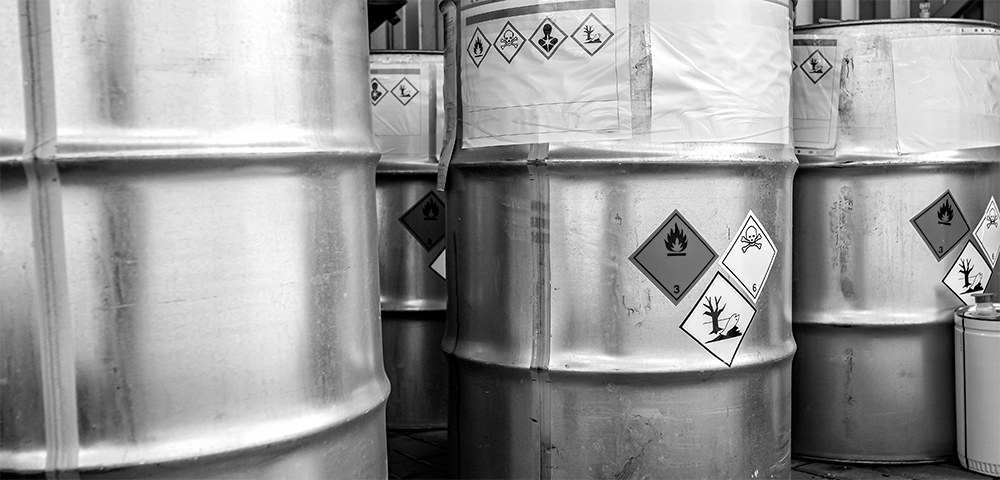
/ IN THIS BLOG
One of the most dangerous types of generated waste are hazardous materials. Because hazardous materials are so potentially harmful to people and the environment, it is always important to properly identify whether you have a waste listed as hazardous waste per the Resource Conservation and Recovery Act (RCRA) or not. One subcategory within this waste type is RCRA metals.
If you generate any hazardous waste in any field (healthcare, industrial, construction, etc.) it is your responsibility to identify, segregate and properly dispose of such waste to prevent contamination to the environment and reduce risk to human health.
If you use metals in your industry, know what RCRA metals are. Such knowledge aids in reducing risk of exposure and contamination. Know your metals. Know their toxicity levels, and above all, know what tests are necessary to identify toxicity. Following established protocols ensures safety for all.
01 / What Is a RCRA Hazardous Waste?
What is the Resource Conservation Recovery Act (RCRA)? This act was passed in 1976, and deals with proper disposal of different waste types or waste streams, such as hazardous waste, regulated medical waste, biological waste, and so forth.
Before RCRA regulations, lack of knowledge and outright negligence resulted in hazardous waste disposal practices in numerous industries and pollutants found their way into waterways, poisoned the landscape, and littered our beaches. The law encourages businesses and industries to be accountable for any improper disposal processes today.
RCRA hazardous waste falls into two categories. Characteristic hazardous waste is either ignitable, reactive, corrosive, or toxic. Listed hazardous waste encompasses waste specifically named by regulatory bodies as hazardous. Review the EPA’s definitions of listed and characteristic hazardous wastes here.
Potentially harmful metals are those that contain components or characteristics (such as toxicity) that are dangerous when absorbed or ingested. When disposed of improperly, such components can leach into the ground or water, polluting everything around it.
02 / What are RCRA Heavy Metals?
What constitutes an RCRA metal? A heavy metal. Heavy metals are those whose atomic density of weight is either equal to or greater than that of water. Because of this density, a heavy metal is more toxic at low concentrations. More information about heavy metals can be found here.
In regard to the environment, several heavy metals are especially toxic. A RCRA metal is one of eight heavy metals identified by RCRA as hazardous. The ‘RCRA 8’ are:
Arsenic
Barium
Cadmium
Chromium
Lead
Mercury
Selemium
Silver
These toxic heavy metals occur naturally in the earth, but when concentrated in unnatural levels, such as in manufacturing processes, they can and do pose extreme risk to humans, animals, and the environment.
These metals do appear in some common household items. For example, some paints contain lead and lightbulbs and batteries contain mercury. However, manufacture of batteries containing mercury has declined in the U.S., with only button cell batteries and mercuric oxide batteries still being manufactured, primarily for medical and military equipment.
Some of these metals are still used in medical treatments - such as chemotherapy - for the treatment of numerous forms of cancer because of their ability to destroy cancerous cells.
However, in medical and manufacturing industries, it is vital to follow the guidelines of the EPA and the RCRA for compliance regarding usage and disposal of such hazardous waste.
03 / US EPA Allowable Limit and Hazardous Waste Codes
The EPA's allowable limit on concentrations of a heavy metal is based on that metal’s level of toxicity. Turn to the Code of Federal Regulations (CFR) Title 40 §261.24 Toxicity characteristic for more detailed information. In a nutshell, the lower the limit, the more dangerous the metal.
While the EPA/RCRA list of metal toxicity characteristics contains several dozen metals, eight of them exhibit higher levels of toxicity than the others, giving them the nickname ‘the RCRA 8’ within the hazardous waste industry.
In brief, the ‘RCRA 8’ are noted, in maximum concentrations and identified by the EPA’s hazardous waste number (HW No.) and its regulatory level (mg/L):
| EPA HW Number/Code | Metal (Contaminant) | Regulatory Lavel (mg/L) - allowable limit in parts per million or PPM |
| D004 | Arsenic | 5.0 |
| D005 | Barium | 100.0 |
| D006 | Cadmium | 1.0 |
| D007 | Chromium | 5.0 |
| D008 | Lead | 5.0 |
| D009 | Mercury | 0.2 |
| D010 | Selenium | 1.0 |
| D011 | Silver | 5.0 |
The level of a metal found in a given sample determines how that waste needs to be disposed of. If the concentration is low enough, the waste would be safe to landfill. If it's too high, it will need to be incinerated.
04 / Testing for Heavy Metals - the Analytical Work
Properly disposing of hazardous waste can only be done after specific laboratory analysis to determine levels of toxicity in metal waste, especially processes using heavy metals. Only testing can reliably determine if hazardous materials are present in a work site or waste stream and the same is true in incidents of heavy metal contamination in some scenarios.
For this reason, analytical tests are highly recommended. Heavy metals won't leave any visual or otherwise perceivable trace, so the only way to know definitively if you have heavy metal contamination (and in what concentration) is by running a toxicity characteristic leaching procedure (TCLP) test. This is done by a laboratory. The waste generator collects a sample of water, soil, or other potentially contaminated source and stores and protects it according to the lab’s instructions until it can be transported to the lab for the actual testing. Results are usually ready within 72 hours though some may take as long as 10 days for results.
Even if you have a Safety Data Sheet (SDS) for your physical or chemical properties, for the most part, this safety data sheet won't tell you the level of the heavy metal(s) present based on minimum requirements of information from the Occupational Safety and Health Administration (OSHA). Testing, therefore, is still necessary – and strongly recommended.
05 / Who Needs Heavy Metal Testing?
A number of business entities and industries should require this testing, such as:
Manufacturers - Testing can determine if a manufacturer's generated waste stream is hazardous, which affects how that manufacturer goes about disposal.
Construction contractors, Demolition Crews, or Engineering Firms - Anyone looking to build a new site should first test the property to confirm there's been no water or soil contamination.
Gun Ranges - Many ammunition types contain lead, and if casings have been on the ground, the area might require special cleaning.
Other industries such as mining, a radiator repair shop, or any location where a past industry or business or new business or structure is planned should obtain testing – better safe than sorry. It’s also important to turn to an experienced and reputable hazardous waste disposal company for disposal of any hazardous waste.
06 / Importance of a Reliable Hazardous Waste Disposal Company
Because of the need for soil or water analysis to determine potential heavy metal contamination, it's important to work with a hazardous waste disposal company that has the appropriate connections to reputable, experienced local labs for sample testing. Most hazardous waste disposal companies will not run such tests themselves, but do turn to established and trusted contacts.
For more information about whether your waste contains any of the RCRA 8 or other EPA or RCRA-regulated wastes, or for other waste management tips, contact a representative of MCF Environmental Services, a hazardous waste management company, serving healthcare, manufacturing, and industrial companies throughout the country.
Your content goes here. Edit or remove this text inline or in the module Content settings. You can also style every aspect of this content in the module Design settings and even apply custom CSS to this text in the module Advanced settings.
Robert Losurdo
President, COO








